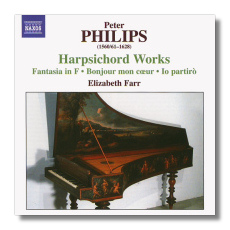
The Internet's Premier Classical Music Source
Related Links
- Philips Reviews
- Latest Reviews
- More Reviews
-
By Composer
-
Collections
DVD & Blu-ray
Books
Concert Reviews
Articles/Interviews
Software
Audio
Search Amazon
Recommended Links
Site News
 CD Review
CD Review
Peter Philips

Harpsichord Works
- Fantasia for Keyboard in F Major
- Amarilli
- Fantasy for Keyboard 'Chi farà fede'
- Pavane for Keyboard
- Deggio Dunque partire
- Io partirò
- Ma voi, caro ben mio
- Pavan and Galliard Pagget
- Bon jour mon cuer
- Le rossignol
- Margott laborez
- Fantasia in D minor
- Fece da voi
- Passamezzo Pavan and Galliard
Elizabeth Farr, harpsichord
Naxos 8.557864
Peter Philips (1560 or 1561-1628) was one of a handful of English Tudor musicians who fell foul of the Elizabethan Church Settlement. In 1582 he went to live in mainland Europe rather than face persecution of Roman Catholics by the Protestant establishment. Indeed he studied with another recusant, William Byrd, before he left. In the first instance Philips went to Rome to familiarize himself with the Italian style so much admired in the late sixteenth century. Thence to Antwerp where he settled in 1597 after a wide and lengthy peregrination throughout Europe; he married, lost both wife and only child soon afterwards and remained attached to the court in Brussels, entered the priesthood; he was ordained in 1609.
Despite being well-known, indeed quite popular, none of Philips' keyboard music was published during his lifetime; all his secular music was composed before he joined the priesthood at the age of about 50. Over half of his surviving keyboard pieces are to be found in the Fitzwilliam Virginal Book, while his complete keyboard works now exist in a comprehensive edition, 'Musica Britannica lxxv', by David Smith (1999). American Elizabeth Farr here plays 16 of Philips best known and most highly-esteemed harpsichord piece on a restored Italian harpsichord built around 1658. The CD is good to have, but the playing at times lacks something of the vivaciousness which would have made it jump off the shelves.
The selection is representative and the sequence enthralling. It contains Intabulations – arrangements of (popular) Italian madrigals and (French/Flemish) chansons idiomatically embellished by Philips in order to convey the expressiveness of the vocal text. Such material accounts for more than half of the composer's output for the keyboard. The pieces are played in such a way here that we can become familiar with them and enjoy their variety, emphasis on technical charm and imagination. But too often Farr's is playing that seems to be treating them more like exercises, expositions, than the lively and regrettably-underperformed delights they are. 'Routine' and somewhat 'uninspired' are words that spring to mind.
Other composers whose original material Philips worked on and which is represented here are Caccini, Striggio, Marenzio and Lassus. Fantasias, dance movements, songs and the colorful 'Le Rossinguol' of Lassus, which has the bird swooping and soaring. The last thing we want is overwrought or gratuitous special effects, but listen to the Paget Pavan in C minor (tr 8); one of Philips' early works (1590?) and probably written in homage to an early patron, Thomas Paget, whose service he'd entered five years earlier. It should sing and at the same time lament, at least evoke a respectful melancholy – if not in the way perhaps only Dowland can, then at least with attachment to its subject, rather than with one eye on the clock.
The CD notes are by Farr herself and cover in nice detail the provenance and points of interest of the music recorded. There's not a word wasted; her analysis of the emotional tenor of the three Marenzio pieces, for example, is helpful and illuminating. Similarly, her cross-referencing one theme to others current at the time (including the ubiquitous ground bass pattern, 'passamezzo antico') is helpful. Total playing time is nearly 80 minutes and the acoustic, if a little dry, is conducive to careful and focused listening. So there are definite shortcomings; if you love the repertoire, you won't want to be without this CD. But since Philips' keyboard corpus is manageable, let's be optimistic that a full version played with real style, vigor and dash is somewhere in the works.
Copyright © 2007, Mark Sealey





















